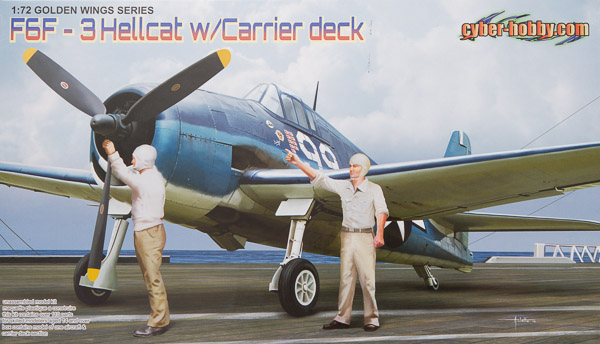
Cyber-Hobby 1/72 F6F-3 Hellcat w/Carrier Deck
By Jacob Russell
The Plane
The Grumman F6F Hellcat was the United States Navy's most important World War II fighter. It accounted for more than 5,000 air-to-air victories in combat against the Japanese, the highest number of aerial kills by any fighter plane in history. This is all the more remarkable if one considers that the Hellcat was the Navy's first line fighter for a mere THREE YEARS.
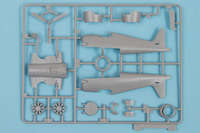
The Kit
The kit comes in Dragon/Cyber-Hobby's usual stout box with colorful, computer-generated artwork of the Hellcat on a carrier deck, "Somewhere in the Pacific", with a pair of deck hands who are a bit goofy looking, frankly. It consists of 141 parts, 9 of which are for the spares box. 4 parts are photo-etched (the seat harness) on a small fret. The rest of the parts are plastic on 12 sprues. 6 pieces are molded in clear plastic and the rest in medium gray. The sprues, p/e and decal sheet are packaged in clear plastic bags.
The kit is in Dragon's "why mold 3 pieces when we can mold 12" school of complexity. The cowling is broken into 5 pieces and the cockpit has more than 15 parts. I would prefer a one piece cowl myself, but the multi-piece cockpit looks great. The detail is well done and it will look great with an oil wash and dry brushed detail. On the other hand, the instrument faces are blank and there's no instrument panel decal included. I would recommend getting a set of Mike Grant instrument face decals for the final touch in what is otherwise a well appointed interior.
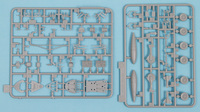
The exhausts are attached to a bulkhead (firewall) and their ends are drilled out, another nice touch. The Pratt & Whitney 18 cylinder R2800 Double Wasp engine is broken into 2 sets of cylinders and a separate crankcase. The detail is adequate for the scale, but not outstanding. The push rods are molded to the cylinder fronts and if you add some spark plug wires you will have a very nice engine. There are 3 pairs of wheels, 2 of which are for the spares box, or for other Hellcat kits with poor wheels, because the wheels are quite good.
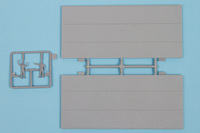
There are minor sink marks on some of the smaller landing gear doors, but the parts are nearly flash free. I poked fun earlier in this review at Dragon's love for multi-piece assemblies, but this approach paid off with the landing gear: each leg is composed of 6 pieces, 7 if you include the wheels and brake lines. The latter are slightly over scale but I will still use them.
The fuselage's surface detail is well done and the inner halves include the ribs and stringers, all of which become invisible when you close up the fuselage. Given the number of ejector pin marks on the fuselage halves, a few of which lie directly on the stringers, ignoring this detail is the best course of action.
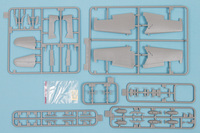
The rudder, lower center wing and ailerons are separate pieces. I like having the option of neutral or deflected control surfaces. You can depict the wings either folded or flight ready so the separate center wing makes sense. The ejection chutes for spent ammo are open rather than merely molded in relief and that is nice to see in 1/72nd scale.
The under wing stores include a drop tank, bombs and racks, and rockets. There is also a “wheels up” option for those inclined to pose the plane “in flight”. Under wing stores include a 150 gallon drop tank, 5” HVAR rockets, and 500 lb. bombs and racks. There is also a "wheels up" option for those inclined to pose the plane "in flight".
The 2 piece carrier deck is well done. You can use it for a diorama base (along with those deck hands I poked fun at earlier; they're actually well molded. Sorry, guys) if so inclined. I like the idea of using the deck as a contest display base for any 1/72nd World War Two or Korean War Navy aircraft. I might cast a resin copy for that very purpose...
The decal sheet provides options for 4 aircraft:
"White 17", VF-9, USS Essex, 1943
"White 99", VF-6, USS Intrepid, 1944
"White F-9", VF-25, USS Cowpens, 1944
"White 10", VMF(N)-534, 1944
All 4 aircraft are in the 3 tone scheme of non-specular blue (FS 35402) on the upper surfaces, non-specular intermediate blue (FS 35164) on the sides and vertical tail and flat white undersides. The first and third decal options have US insignia with red surrounds. The decal sheet includes a complete set of stencils.
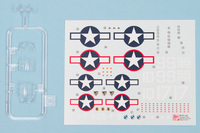
Cyber-Hobby's instructions include a parts map and color callouts for Gunze Mr. Color lacquer, Mr. Hobby acrylic and Model Master enamel paints. The instructions are well illustrated with a logical build sequence.
Accuracy
Bert Kinzey's F6F in Detail & Scale provides the following dimensions for the F6F : the wingspan is 42' 10", the length is 33' 7", and the height (3 point) is 11' 7". In 1/72nd scale those dimensions are 10.71", 8.40" and 2.90" respectively. I laid the outer wings and fuselage over the plans and the parts were very close. I cannot vouch for the accuracy of the plans. The kit parts are close enough for me.
The standard armament for most Hellcats was 6 .50 caliber Colt/Browning machine guns. A mixed battery of 2 20mm cannon and 4 .50 caliber machine guns was tested but not adopted on standard Hellcat fighters. Many F6F-5N night fighters used this armament. The wings are molded with the cannon housings on the wing leading edges so remove them, and use the provided inserts, to make an accurate F6F-3. The instructions don't mention the need to remove the cannon housings.
Conclusions
I am not an expert on the Hellcat, but I think this is a good kit. The Cyber-Hobby kit's main competition is probably the recent Eduard Hellcat series. It supersedes the earlier offerings of Italeri, Hasegawa and Academy, all of which are fairly long in the tooth. Cyber-Hobby's kit is accurate and well detailed and I think you can build an excellent F6F-3 Hellcat with it. I would like to thank Dragon USA for providing the review sample.
References
F6F Hellcat Walk Around, Walk Around No.9, by Richard S. Dann, Squadron/Signal Publications, 1996.
F6F Hellcat in Detail & Scale, Volume 26, by Bert Kinzey, Tab Books, 1987.
